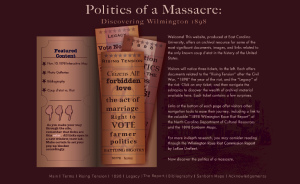talking history | syllabi | students | teachers | puzzle | about us
Politics of a Massacre: Discovering Wilmington 1898
http://core.ecu.edu/umc/wilmington/index.html
Created and maintained by East Carolina University.
Reviewed Aug. 2010.
In November 1898, crowds of white men stormed the streets of Wilmington, North Carolina, terrorized the city’s African American community, and ousted the democratically elected government from office. As the culmination of the “white supremacy campaigns” calculated to rally white North Carolinians to the Democratic party and against the biracial Fusion government of Republicans and Populists, the outbreak proved quite effective—the backs of the Fusionists were broken. The vibrant community that had sustained black political participation in Wilmington lay in ruins—with somewhere between twenty and two hundred African Americans dead and countless more exiled. Emboldened by the success of their coup, Democrats in North Carolina moved to secure power by writing disfranchisement into the state constitution. More than just a rallying cry, white supremacy became the law of the land.

The online resource Politics of a Massacre examines the revolution in Wilmington and its underlying causes and effects. Produced by the historian Karin L. Zipf and the Multimedia Center at East Carolina University, the Web site aggregates a host of sources for students, teachers, and the general public, while shaping a narrative of democratic flowering cut down by southern politics. The main page links to three “tickets,” or sections. “Rising Tension” includes subcategories addressing citizenship, the regulation of sex and marriage, Populism, and race relations; “1898” tracks the precipitating events and the unfolding of the coup, from the Democratic rhetoric of white male solidarity and the actions of the paramilitary groups that enforced it to the series of murders and expulsions that followed; “Legacy” looks at North Carolina’s turn to Jim Crow through subcategories on lynching, disfranchisement, segregation, and civil rights struggles. Carrying the narrative through contemporary attempts either to make amends for or to downplay events in Wilmington, “Legacy” also points to the ways the history and consequences of the coup remain contested.
Politics of a Massacre is dense. In addition to having scanned material, the site makes good use of other online archives by connecting to sources in the University of North Carolina’s Documenting the American South Web site, for example, and the final report produced by the 1898 Wilmington Race Riot Commission in 2006. Each subcategory under the tickets contains multiple links to material ranging from witness recollections to photo galleries, court cases, and an interactive map. Some links merely complement the narrative while others, such as the one to the map, are crucial to its unfolding. Unfortunately, one cannot always tell from reading the narrative which will be the case, and the site can occasionally feel gratuitously dynamic. A sidebar on the main page highlights “Featured Content,” but a basic site map would help navigation immensely.
Politics of a Massacre, however, remains invaluable for anyone interested in the Wilmington coup. It offers a powerful narrative while providing enough material and varying perspectives to spur users to develop their own interpretations. Moreover, the site is powerful. As the main page opens, a black North Carolinian sings, “Remember Me.” Because of resources such as this site, and the scholarship from which it draws, the massacre and its legacies will not be forgotten.
Adriane Lentz-Smith
Duke University
Durham, North Carolina
